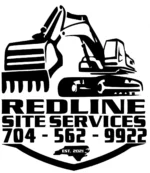Erosion on sloped properties in Union County is a growing concern, and proper management techniques can protect land and prevent costly repairs. Heavy rainfall and steep terrain increase soil loss and property damage.
Why Erosion Control Matters for Sloped Properties in Union County
Sloped properties face unique erosion challenges due to gravity and water flow. Union County’s average annual rainfall of 45 inches accelerates soil displacement. Without control measures, erosion leads to:
- Loss of fertile topsoil.
- Increased sediment in waterways.
- Structural damage to foundations.
Call us at (704) 562-9922 for expert land clearing & erosion control tailored to Union County’s conditions.
Key Causes of Erosion on Sloped Properties
Several factors contribute to erosion on slopes. Understanding these causes helps implement effective solutions. Key factors include:
- Heavy rainfall washing away soil.
- Lack of vegetation to stabilize the ground.
- Improper grading increases runoff.
Addressing these issues reduces risks significantly.
Effective Techniques for Managing Erosion on Slopes
Proven techniques minimize soil loss on sloped properties. Below are the methods used in Union County:
- Plant native vegetation to anchor soil.
- Install terraces to slow water flow.
- Use retaining walls for structural support.
Each method suits specific slope conditions. Combining techniques improves results.
Benefits of Terracing for Sloped Properties
Terracing transforms steep slopes into level steps. This technique reduces water speed and soil displacement. Key benefits include:
- Creates flat areas for planting.
- Prevents gullies from forming.
- Enhances land usability for agriculture.
Terracing requires professional design but offers long-term advantages.
Cost Breakdown for Erosion Control Methods
Different methods vary in cost and effectiveness. Below is a table summarizing typical expenses:
| Method Type | Cost Range | Effectiveness Rating | Maintenance Needs |
|---|---|---|---|
| Terracing | $2,000 – $5,000 | Very High | Moderate |
| Retaining Walls | $3,000 – $10,000 | High | Low |
| Vegetation Planting | $500 – $2,000 | Medium | High |
These figures help property owners choose suitable options.
Frequently Asked Questions About Slope Erosion
What happens if erosion is ignored?
Ignoring erosion leads to property damage and environmental harm. Sediment runoff affects 40% of water bodies in Union County.
Can erosion be reversed?
Yes, but reversing erosion requires significant effort. Techniques like terracing and reforestation restore damaged areas.
How long does erosion control last?
Control measures last 5 to 10 years with proper maintenance. Regular inspections extend their lifespan.
Common Mistakes in Erosion Management
Many property owners make errors when addressing erosion. Avoid these common mistakes:
- Ignoring early warning signs like bare patches.
- Using temporary fixes like sandbags.
- Skipping professional assessments.
Mistakes increase repair costs by 60% over time.
Environmental Impact of Poor Erosion Control
Poor erosion control harms the environment. Sediment runoff pollutes waterways. Key impacts include:
- Contaminated drinking water sources.
- Loss of aquatic habitats.
- Spread of harmful pathogens.
Proper solutions reduce contamination risks by 35%.
Regulations for Erosion Control in Union County
Union County enforces strict erosion control regulations. Non-compliance results in fines and project delays. Key rules include:
- Mandatory silt fences for construction sites.
- Vegetative cover is required on exposed soil.
- Inspections every 6 months for compliance.
Violations lead to penalties of up to $5,000.
How Redline Site Services Supports Erosion Control
Redline Site Services specializes in erosion control solutions for Union County. Our team provides comprehensive support. Services include:
- Detailed site assessments.
- Custom erosion control designs.
- Long-term maintenance plans.
Call us at (704) 562-9922 for expert grading services and erosion expertise.
Tips for Planting Vegetation on Slopes
Vegetation stabilizes soil and prevents erosion. Native plants adapt well to local conditions. Key tips include:
- Choose deep-rooted species like shrubs and grasses.
- Space plants evenly to maximize coverage.
- Mulch around plants to retain moisture.
Planting reduces soil loss by 40%, offering sustainable protection.
Impact of Heavy Rainfall on Sloped Properties
Heavy rainfall increases erosion risks on slopes. Water flows faster downhill, carrying soil with it. Key impacts include:
- Formation of gullies and rills.
- Increased sediment in nearby streams.
- Damage to structures near slopes.
Proper drainage systems reduce runoff by 50%, protecting properties.
Steps to Inspect Your Property for Erosion Risks
Regular inspections identify erosion risks before they worsen. Key steps include:
- Check for bare or eroded patches.
- Look for signs of water pooling or runoff paths.
- Monitor vegetation health on slopes.
Early detection saves homeowners $1,000 to $3,000 in repairs annually.
How to Design Effective Drainage Systems for Slopes
Drainage systems redirect water away from slopes. Proper design prevents soil displacement. Key elements include:
- French drains to channel water.
- Swales to slow water flow.
- Gravel beds to absorb excess water.
These systems reduce erosion risks by 30%, extending property life.
Call Us for Expert Guidance
Need help managing erosion on your sloped property in Union County? Call us at (704) 562-9922. Our team offers expert septic tank services and tailored erosion control solutions.
Sources:
